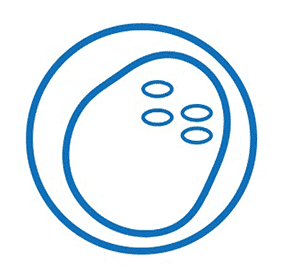Clinically relevant GI parasites
Clinically Relevant Gastrointestinal Parasites
There is increasing evidence and recognition of numerous parasites that cause symptoms of gastroenteritis.1,2,3 Whilst some are more common, there are emerging protozoan infections that are becoming of more interest to clinicians and diagnostic laboratories. The table below summarises 8 clinically relevant gastrointestinal parasites that are a disease burden in the US. These gastrointestinal parasites can be screened efficiently by molecular multiplex-PCR technology, and compliment traditional methods, such as stool ova and parasite microscopic exams.
Click the tiles below to learn more about each gastrointestinal pathogen.
Genetic Signatures' GI parasite panel & automated workflow now cleared by the FDA for sale in the United States

Giardia duodenalis
Giardiasis is one of the leading GI parasitic infections, regularly associated with waterborne parasite outbreaks in summer months. Infection is underreported at 20.000 cases in the US each year, with real cases estimated at 1-2 million cases in the US alone.4,5 Giardia infection rarely cause death in the US, however, 4,600 people are hospitalized with giardiasis each year.4

Cryptosporidium spp.
There are more than 2.9 million cases of cryptosporidiosis recorded each year in children aged < 24 months in sub-Saharan Africa alone.6 In the US, an estimated 748,000 cryptosporidiosis cases occur each year. Higher transmission is recorded in summer months with increased recreational water use.7

Entamoeba histolytica
Amebiasis results in 100,000 human deaths annually on a global scale.6 In the US, incidence of amebiasis is low and mostly seen in returning travelers or immigrants from developing countries. In the US, amebiasis-related deaths still occur occasionally, at around five deaths per year. 8

Cyclospora cayetanensis
Between 2018 to 2021 there have been roughly 6,000 domestically-acquired cases of cyclosporiasis in the US, though like other GI parasitic infections, cases are thought to be underreported.9 Outbreaks in the US have been linked to ingestion of contaminated food and water. Infection is also associated with foreign travel.

Blastocystis hominis
B. hominis is the predominant parasite found in human stool samples, with a higher prevalence in developing countries (50-60%) than developed countries (about 10% or less).12 It has been suggested that B. hominis may be a commensal organism that becomes pathogenic when the host is immunosuppressed, malnourished or has other infections.13

Microsporidia
(Enterocytozoon bieneusil
Encephalitozoon intestinalis)
Microsporidia are increasingly recognized as opportunistic infectious agents worldwide.14 In developed countries prevalence rates for enteric microsporidiosis in HIV-seropositive persons with diarrhea has been seen to range from 2% to 78%.15,16
Other gastrointestinal infections
Genetic Signatures multiplex real-time PCR assays provide detection for over 30 bacterial, viral and parasite targets. For more information about other targets in our gastrointestinal product range, click here.
For more information on the regulatory status in your region, contact our team at [email protected]
Syndromic testing for 8 gastrointestinal parasites in a single test
Up to 60 patients screened in a single, automated workflow...with same day reporting!

Find out more about our unique 3base™ solution for detecting gastrointestinal parasites
More Information
References
- Benedict KM et al. (2019), Case-case analyses of cryptosporidiosis and giardiasis using routine national surveillance data in the United States, 2005. Epidemiol Infect, 147: e178.
- Casillas SM et al. (2018), Notes from the Field: Multiple Cyclosporiasis Outbreaks — United States, 2018. Morb Mortal Wkly Rep, 67: 1101–1102.
- Shirley DT et al. (2018), A Review of the Global Burden, New Diagnostics, and Current Therapeutics for Amebiasis. Open Forum Infect Dis, 5(7): ofy161.
- Coffey CM et al. (2021), Evolving Epidemiology of Reported Giardiasis Cases in the United States, 1995–2016. Clin Infect Dis, ciaa128.
- Cama VA & Mathison BA (2015), Infections by Intestinal Coccidia and Giardia duodenalis. Clin Lab Med, 35(2): 423–444
Giardia Factsheet - Ryan U et al. (2017), New Technologies for Detection of Enteric Parasites. Trends Parasitol, 33(7): 532– 546.
- Benedict KM et al. (2019), Case-case analyses of cryptosporidiosis and giardiasis using routine national surveillance data in the United States, 2005. Epidemiol Infect, 147: e178.
- Shirley DT et al. (2018), A Review of the Global Burden, New Diagnostics, and Current Therapeutics for Amebiasis. Open Forum Infect Dis, 5(7): ofy161.
- U.S. Food & Drug Administration (FDA), 2021, FDA Releases Cyclospora Prevention, Response and Research Action Plan, [online] Accessed on 31/03/2022. Science Direct, [online] Accessed on 31/03/2022.
- Duda, A., et al. (2015), The prevalence of Blastocystis hominis and other protozoan parasites in soldiers returning from peacekeeping missions, Am J Trop Med Hyg, 92(4), 805–806.
- World Health Organisation (WHO), Blastocystis, [online] Accessed on 31/03/2022.
- Stark, D., et al. (2009). Clinical significance of enteric protozoa in the immunosuppressed human population. Clinical Microbiology Reviews.
- Didier, E.S., et al. (2004). Epidemiology of microsporidiosis: sources and modes of transmission. Veterinary Parasitology. 126, pp. 145–166.
- Matos, O., et al. (2012). Epidemiology of Enterocytozoon bieneusi Infection in Humans. Journal of Parasitology Research. 2012, pp. 981424.
- Garcia LS et al. (2017), Practical Guidance for Clinical Microbiology Laboratories: Laboratory Diagnosis of Parasites from the Gastrointestinal Tract. Clin Microbiol Rev, 15; 31(1).
- McHardy IH et al. (2014), Detection of intestinal protozoa in the clinical laboratory. J Clin Microbiol, 52: 712–720.
- Stark D et al. (2014) Evaluation of the EasyScreen™ enteric parasite detection kit for the detection of Blastocystis spp., Cryptosporidium spp., Dientamoeba fragilis, Entamoeba complex, and Giardia intestinalis from clinical stool samples. Diagn Microbiol Infect Dis, 78(2): 149–52.
- Dirani G et al. (2019), EasyScreen™ Enteric Protozoa Assay For the Detection of Intestinal Parasites: A Retrospective Bi-Center Study. J Parasitol, 105(1): 58–63
- Siah SP et al. (2014), Improved detection of gastrointestinal pathogens using generalised sample processing and amplification panels. Pathology, 46(1): 53–9.
- Golan Y et al. (2005), Empirical anti-Candida therapy among selected patients in the intensive care unit: a cost-effectiveness analysis. Ann Intern Med, 143: 857–869.
- Dasta JF et al. (2005), Daily cost of an intensive care unit day: the contribution of mechanical ventilation. Crit Care Med, 33: 1266–1271.


